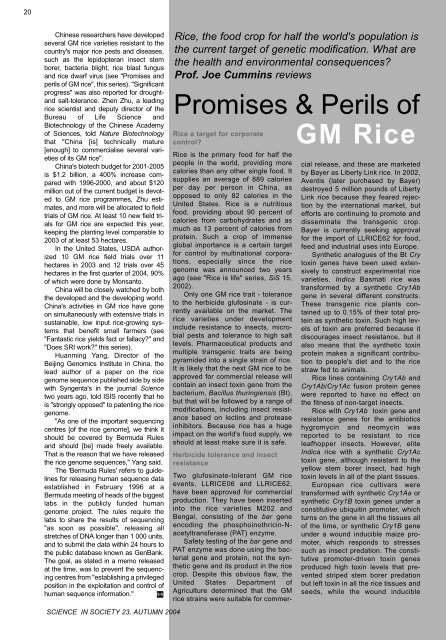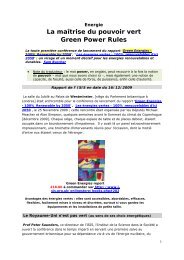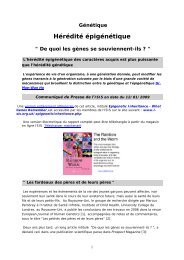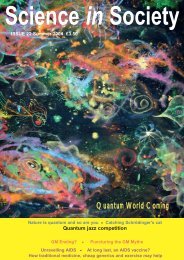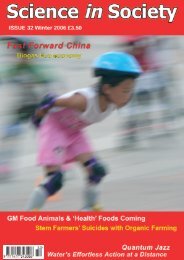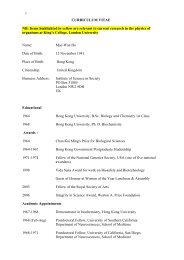Ethiopia goes organic to feed herself - The Institute of Science In ...
Ethiopia goes organic to feed herself - The Institute of Science In ...
Ethiopia goes organic to feed herself - The Institute of Science In ...
Create successful ePaper yourself
Turn your PDF publications into a flip-book with our unique Google optimized e-Paper software.
20<br />
Chinese researchers have developed<br />
several GM rice varieties resistant <strong>to</strong> the<br />
country's major rice pests and diseases,<br />
such as the lepidopteran insect stem<br />
borer, bacteria blight, rice blast fungus<br />
and rice dwarf virus (see "Promises and<br />
perils <strong>of</strong> GM rice", this series). "Significant<br />
progress" was also reported for droughtand<br />
salt-<strong>to</strong>lerance. Zhen Zhu, a leading<br />
rice scientist and deputy direc<strong>to</strong>r <strong>of</strong> the<br />
Bureau <strong>of</strong> Life <strong>Science</strong> and<br />
Biotechnology <strong>of</strong> the Chinese Academy<br />
<strong>of</strong> <strong>Science</strong>s, <strong>to</strong>ld Nature Biotechnology<br />
that "China [is] technically mature<br />
[enough] <strong>to</strong> commercialise several varieties<br />
<strong>of</strong> its GM rice".<br />
China's biotech budget for 2001-2005<br />
is $1.2 billion, a 400% increase compared<br />
with 1996-2000, and about $120<br />
million out <strong>of</strong> the current budget is devoted<br />
<strong>to</strong> GM rice programmes, Zhu estimates,<br />
and more will be allocated <strong>to</strong> field<br />
trials <strong>of</strong> GM rice. At least 10 new field trials<br />
for GM rice are expected this year,<br />
keeping the planting level comparable <strong>to</strong><br />
2003 <strong>of</strong> at least 53 hectares.<br />
<strong>In</strong> the United States, USDA authorized<br />
10 GM rice field trials over 11<br />
hectares in 2003 and 12 trials over 45<br />
hectares in the first quarter <strong>of</strong> 2004, 90%<br />
<strong>of</strong> which were done by Monsan<strong>to</strong>.<br />
China will be closely watched by both<br />
the developed and the developing world.<br />
China's activities in GM rice have gone<br />
on simultaneously with extensive trials in<br />
sustainable, low input rice-growing systems<br />
that benefit small farmers (see<br />
"Fantastic rice yields fact or fallacy?" and<br />
"Does SRI work?" this series).<br />
Huanming Yang, Direc<strong>to</strong>r <strong>of</strong> the<br />
Beijing Genomics <strong><strong>In</strong>stitute</strong> in China, the<br />
lead author <strong>of</strong> a paper on the rice<br />
genome sequence published side by side<br />
with Syngenta's in the journal <strong>Science</strong><br />
two years ago, <strong>to</strong>ld ISIS recently that he<br />
is "strongly opposed" <strong>to</strong> patenting the rice<br />
genome.<br />
"As one <strong>of</strong> the important sequencing<br />
centres [<strong>of</strong> the rice genome], we think it<br />
should be covered by Bermuda Rules<br />
and should [be] made freely available.<br />
That is the reason that we have released<br />
the rice genome sequences," Yang said.<br />
<strong>The</strong> 'Bermuda Rules' refers <strong>to</strong> guidelines<br />
for releasing human sequence data<br />
established in February 1996 at a<br />
Bermuda meeting <strong>of</strong> heads <strong>of</strong> the biggest<br />
labs in the publicly funded human<br />
genome project. <strong>The</strong> rules require the<br />
labs <strong>to</strong> share the results <strong>of</strong> sequencing<br />
"as soon as possible", releasing all<br />
stretches <strong>of</strong> DNA longer than 1 000 units,<br />
and <strong>to</strong> submit the data within 24 hours <strong>to</strong><br />
the public database known as GenBank.<br />
<strong>The</strong> goal, as stated in a memo released<br />
at the time, was <strong>to</strong> prevent the sequencing<br />
centres from "establishing a privileged<br />
position in the exploitation and control <strong>of</strong><br />
human sequence information."<br />
SiS<br />
SCIENCE IN SOCIETY 23, AUTUMN 2004<br />
Rice, the food crop for half the world's population is<br />
the current target <strong>of</strong> genetic modification. What are<br />
the health and environmental consequences?<br />
Pr<strong>of</strong>. Joe Cummins reviews<br />
Promises & Perils <strong>of</strong><br />
GM Rice<br />
Rice a target for corporate<br />
control?<br />
Rice is the primary food for half the<br />
people in the world, providing more<br />
calories than any other single food. It<br />
supplies an average <strong>of</strong> 889 calories<br />
per day per person in China, as<br />
opposed <strong>to</strong> only 82 calories in the<br />
United States. Rice is a nutritious<br />
food, providing about 90 percent <strong>of</strong><br />
calories from carbohydrates and as<br />
much as 13 percent <strong>of</strong> calories from<br />
protein. Such a crop <strong>of</strong> immense<br />
global importance is a certain target<br />
for control by multinational corporations,<br />
especially since the rice<br />
genome was announced two years<br />
ago (see "Rice is life" series, SiS 15,<br />
2002).<br />
Only one GM rice trait - <strong>to</strong>lerance<br />
<strong>to</strong> the herbicide glufosinate - is currently<br />
available on the market. <strong>The</strong><br />
rice varieties under development<br />
include resistance <strong>to</strong> insects, microbial<br />
pests and <strong>to</strong>lerance <strong>to</strong> high salt<br />
levels. Pharmaceutical products and<br />
multiple transgenic traits are being<br />
pyramided in<strong>to</strong> a single strain <strong>of</strong> rice.<br />
It is likely that the next GM rice <strong>to</strong> be<br />
approved for commercial release will<br />
contain an insect <strong>to</strong>xin gene from the<br />
bacterium, Bacillus thuringiensis (Bt),<br />
but that will be followed by a range <strong>of</strong><br />
modifications, including insect resistance<br />
based on lectins and protease<br />
inhibi<strong>to</strong>rs. Because rice has a huge<br />
impact on the world's food supply, we<br />
should at least make sure it is safe.<br />
Herbicide <strong>to</strong>lerance and insect<br />
resistance<br />
Two glufosinate-<strong>to</strong>lerant GM rice<br />
events, LLRICE06 and LLRICE62,<br />
have been approved for commercial<br />
production. <strong>The</strong>y have been inserted<br />
in<strong>to</strong> the rice varieties M202 and<br />
Bengal, consisting <strong>of</strong> the bar gene<br />
encoding the phosphoinothricin-Nacetyltransferase<br />
(PAT) enzyme.<br />
Safety testing <strong>of</strong> the bar gene and<br />
PAT enzyme was done using the bacterial<br />
gene and protein, not the synthetic<br />
gene and its product in the rice<br />
crop. Despite this obvious flaw, the<br />
United States Department <strong>of</strong><br />
Agriculture determined that the GM<br />
rice strains were suitable for commercial<br />
release, and these are marketed<br />
by Bayer as Liberty Link rice. <strong>In</strong> 2002,<br />
Aventis (later purchased by Bayer)<br />
destroyed 5 million pounds <strong>of</strong> Liberty<br />
Link rice because they feared rejection<br />
by the international market, but<br />
efforts are continuing <strong>to</strong> promote and<br />
disseminate the transgenic crop.<br />
Bayer is currently seeking approval<br />
for the import <strong>of</strong> LLRICE62 for food,<br />
<strong>feed</strong> and industrial uses in<strong>to</strong> Europe.<br />
Synthetic analogues <strong>of</strong> the Bt Cry<br />
<strong>to</strong>xin genes have been used extensively<br />
<strong>to</strong> construct experimental rice<br />
varieties. <strong>In</strong>dica Basmati rice was<br />
transformed by a synthetic Cry1Ab<br />
gene in several different constructs.<br />
<strong>The</strong>se transgenic rice plants contained<br />
up <strong>to</strong> 0.15% <strong>of</strong> their <strong>to</strong>tal protein<br />
as synthetic <strong>to</strong>xin. Such high levels<br />
<strong>of</strong> <strong>to</strong>xin are preferred because it<br />
discourages insect resistance, but it<br />
also means that the synthetic <strong>to</strong>xin<br />
protein makes a significant contribution<br />
<strong>to</strong> people's diet and <strong>to</strong> the rice<br />
straw fed <strong>to</strong> animals.<br />
Rice lines containing Cry1Ab and<br />
Cry1Ab/Cry1Ac fusion protein genes<br />
were reported <strong>to</strong> have no effect on<br />
the fitness <strong>of</strong> non-target insects.<br />
Rice with Cry1Ab <strong>to</strong>xin gene and<br />
resistance genes for the antibiotics<br />
hygromycin and neomycin was<br />
reported <strong>to</strong> be resistant <strong>to</strong> rice<br />
leafhopper insects. However, elite<br />
<strong>In</strong>dica rice with a synthetic Cry1Ac<br />
<strong>to</strong>xin gene, although resistant <strong>to</strong> the<br />
yellow stem borer insect, had high<br />
<strong>to</strong>xin levels in all <strong>of</strong> the plant tissues.<br />
European rice cultivars were<br />
transformed with synthetic Cry1Aa or<br />
synthetic Cry1B <strong>to</strong>xin genes under a<br />
constitutive ubiquitin promoter, which<br />
turns on the gene in all the tissues all<br />
<strong>of</strong> the time, or synthetic Cry1B gene<br />
under a wound inducible maize promoter,<br />
which responds <strong>to</strong> stresses<br />
such as insect predation. <strong>The</strong> constitutive<br />
promoter-driven <strong>to</strong>xin genes<br />
produced high <strong>to</strong>xin levels that prevented<br />
striped stem borer predation<br />
but left <strong>to</strong>xin in all the rice tissues and<br />
seeds, while the wound inducible


